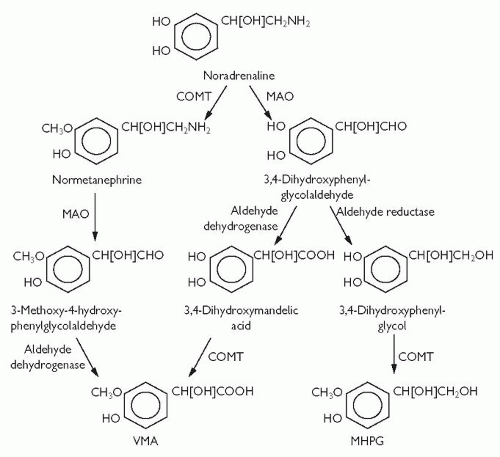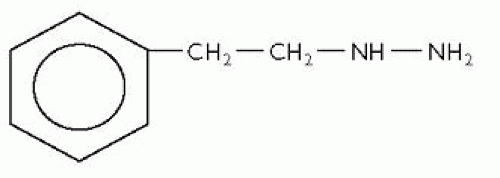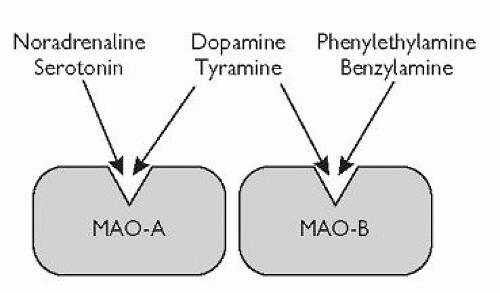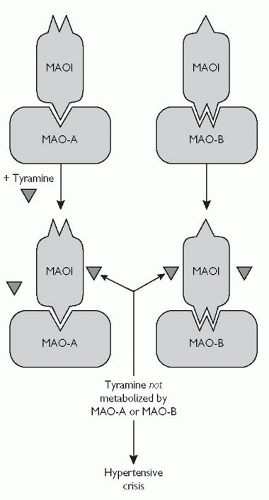Monoamine-Oxidase Inhibitors
The use of MAOIs
The enzyme monoamine oxidase (MAO), found mainly in the external mitochondrial membrane, acts on central nervous system neurotransmitters such as noradrenaline, serotonin, and dopamine. The involvement of MAO in the metabolic degradation of noradrenaline is shown in Fig. 8.1. MAO catalyses the catabolism of serotonin into 5-hydroxyindoleacetic acid, or 5-HIAA for short.
Monoamine oxidase inhibitors, conventionally abbreviated to MAOIs, act by inhibiting the metabolic degradation of monoamines by MAO. The differing actions of MAO-A and MAO-B are shown in Fig. 8.2.
Traditional MAOIs are non-selective, inhibiting the actions of both MAO-A and MAO-B (see Fig. 8.3). Since these MAOIs inhibit the peripheral catabolism of pressor amines, and in particular that of dietary tyramine, it is vitally important that patients taking MAOIs avoid foodstuffs that contain tyramine. Eating tyramine-rich food while taking an MAOI can otherwise lead to a potentially fatal hypertensive crisis. Certain drugs, including over-the-counter medicines like cough remedies, should also be avoided while taking MAOIs (see bullet list below). These restrictions have tended to limit the use of MAOIs in non-inpatients.
Foods which must be avoided while being treated with MAOIs include:
cheese (except cottage cheese and cream cheese)
meat extracts
yeast extracts
fermented soya bean products
alcohol (particularly chianti, fortified wines and beer)
non-fresh fish
non-fresh meat
non-fresh poultry
offal
avocado
banana skins
broad-bean pods
caviar
herring (pickled or smoked).
Medicines which must be avoided while taking MAOIs include:
Indirectly-acting sympathomimetic amines, such as:
ephedrine
fenfluramine.
Cough mixtures containing sympathomimetics.
Nasal decongestants containing sympathomimetics.
L-dopa.
Opioid analgesics, particularly pethidine.
Tricyclic antidepressants (the combination of the MAOI tranylcypromine with the tricyclic antidepressant clomipramine is particularly dangerous).
The British National Formulary gives the following advice on the use of MAOIs before and after (and indeed in addition to) other antidepressants.
 Fig. 8.1 Catabolic pathways for noradrenaline. Reproduced with permission from Puri BK and Tyrer PJ (1998). Sciences Basic to Psychiatry, 2nd edn. Churchill Livingstone, Edinburgh. |
‘Other antidepressants should not be started for 2 weeks after treatment with MAOIs has been stopped (3 weeks if starting clomipramine or imipramine). Some psychiatrists use selected tricyclics in conjunction with MAOIs but this is hazardous, indeed potentially lethal, except in experienced hands and there is no evidence that the combination is more effective than when either constituent is used alone. The combination of tranylcypromine with clomipramine is particularly dangerous.
Conversely, an MAOI should not be started until at least 7-14 days after a tricyclic or related antidepressant (3 weeks in the case of clomipramine or imipramine) has been stopped.
In addition, an MAOI should not be started for at least 2 weeks after a previous MAOI has been stopped (then started at a reduced dose).’
Patients being prescribed MAOIs should be given MAOI treatment cards which list precautions to be taken. These should be issued to the patient by either the prescribing doctor or the dispensing pharmacy.
Choice
Traditional MAOIs which are currently available for prescription fall into two groups:
Hydrazine:
phenelzine
isocarboxazid.
Hon-hydrazine:
tranylcypromine.
The non-hydrazine MAOI tranylcypromine may cause dependency. The reason for this is not certain. One possibility put forward is that the cyclopropyl ring of tranylcypromine (see Fig. 8.6) may be cleaved after administration of the drug to form amfetamine (amphetamine), although there is no clear evidence in favour of this possibility (see, for example, Sherry et al., 2000). In contrast, the hydrazine MAOIs, phenelzine, and isocarboxazid, are less likely to be stimulant and cause dependency, and may therefore be preferred clinically to tranylcypromine.
Withdrawal
Withdrawal from pharmacotherapy with MAOIs should ideally take place very gradually.
Phenelzine
 Fig. 8.4 The structure of phenelzine.
Stay updated, free articles. Join our Telegram channel
Full access? Get Clinical Tree
 Get Clinical Tree app for offline access
Get Clinical Tree app for offline access

|




